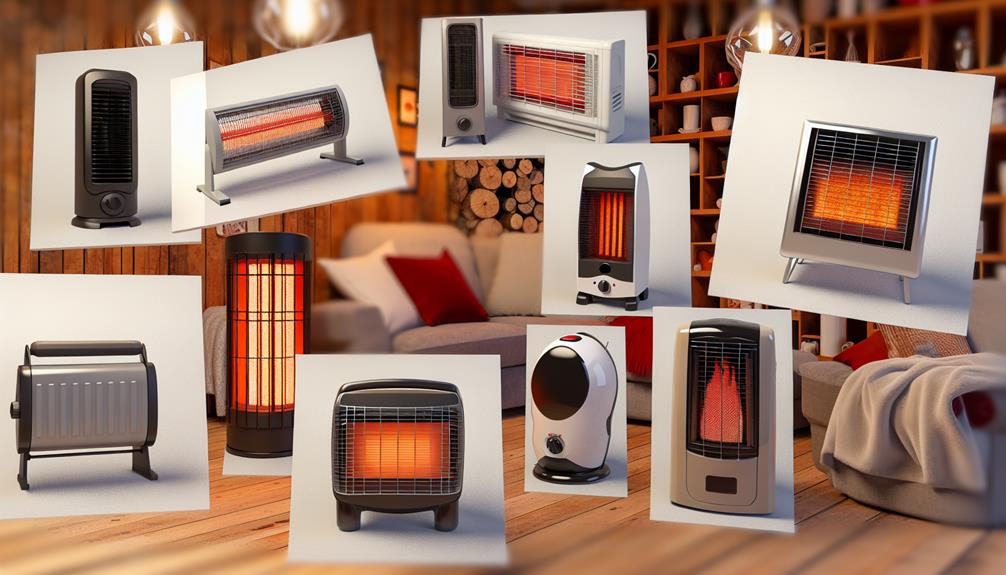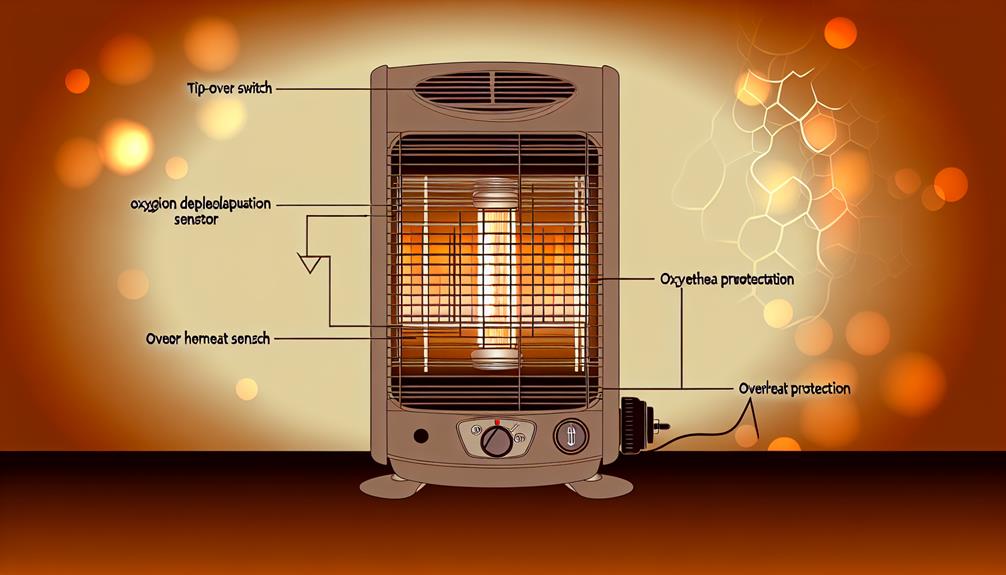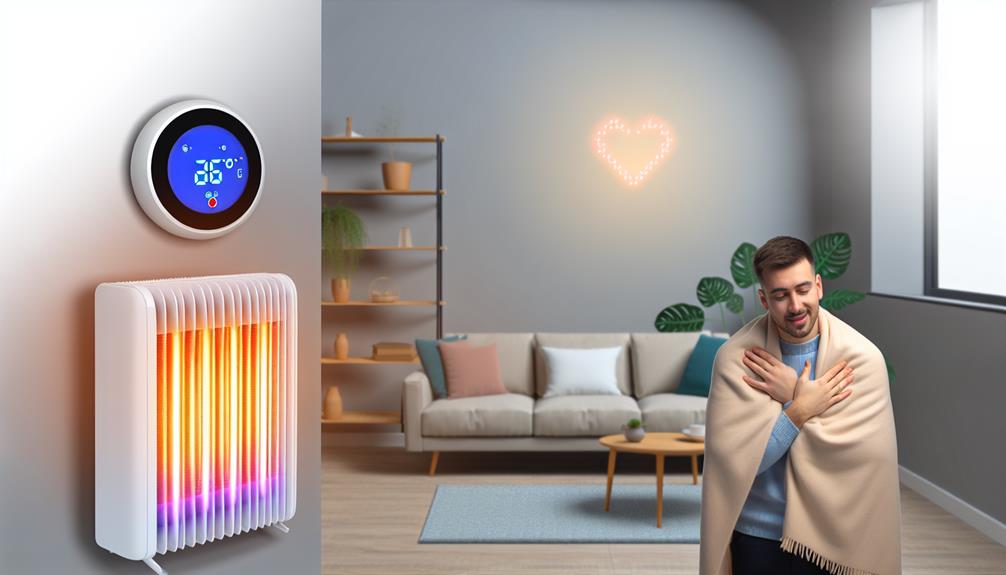As winter's chill tightens its grip on your home, it's tempting to reach for the quick comfort of a portable heater. You're aware of the cozy warmth they can provide, but it's crucial to also recognize the potential risks that come with improper use. As you navigate the labyrinth of safety protocols and best practices, you'll find that mastering the use of portable heaters isn't just about fending off the cold—it's about ensuring the warmth doesn't come at a cost. From understanding the different types of heaters to knowing where to place them and what safety features are non-negotiable, you're about to embark on a journey that will not only enhance your comfort but also protect your sanctuary. Stick with us, and you'll uncover the golden rules that will keep you safe and snug when the frosty weather demands a little extra heat.
Key Takeaways
- Understand the different types of portable heaters available, such as convection, radiant, ceramic, oil-filled, and micathermic heaters.
- Choose the right location for your portable heater, keeping it away from flammable materials and placing it on a stable surface.
- Look for essential safety features in a portable heater, including automatic shut-off, tip-over protection, adequate ventilation, and childproofing designs.
- Follow best practices for heater operation, such as maintaining proper ventilation, performing regular maintenance checks, and inspecting the wiring for signs of damage.
Understanding Portable Heater Types

When choosing a portable heater, it's essential to understand the different types available to ensure you're picking a safe and suitable option for your space. Heater efficiency and energy consumption are crucial factors that will affect both your comfort and your utility bills.
First, consider convection heaters, which warm the air in a room by circulating it across heating elements. These are typically energy-efficient for large, enclosed spaces, but they do take some time to affect the room's overall temperature.
Radiant heaters, on the other hand, provide immediate warmth to objects and people in their path by emitting infrared radiation. They're ideal for spot heating or smaller areas but may not be the best choice for heating an entire room evenly.
Another option is the ceramic heater, which combines the principles of both convection and radiant heating. These heaters are generally compact, offer quick heating, and maintain a cool exterior, which can be a significant safety advantage.
Oil-filled heaters are known for their ability to retain heat, making them energy-efficient for prolonged use. They operate quietly and can be an excellent choice for bedrooms or studies. However, they are heavy and can take longer to heat up.
Micathermic heaters, a less common type, use both convection and radiant technology and have a fast response time. They're lightweight and silent, with a slim profile for easy placement in any room.
Choosing the Right Heater Location
Selecting an optimal spot for your portable heater is crucial for maximizing efficiency and ensuring safety in your home. You've got to consider not just heater aesthetics, but more importantly, the practicality and safety of its location. Here's how you can nail down the perfect spot.
First off, it's paramount to keep the heater away from any flammable materials. Curtains, furniture, and bedding should maintain a safe distance of at least three feet from the heater. This buffer zone minimizes the risk of fire, giving you peace of mind.
Now, don't just plunk your heater down anywhere. Check that the heater is on a level, hard surface. Carpets and rugs aren't ideal—they can overheat and aren't as stable. Plus, you want to avoid any tripping hazards or the possibility of the unit getting knocked over.
Let's talk zoning regulations. These rules aren't just red tape—they're there for your safety. Make sure you're up to date with any local codes that might dictate where you can and can't place a heater. Ignorance isn't bliss when it comes to safety.
Consider the room's layout for optimal heat distribution. You don't want to stick the heater in a remote corner where it'll hog all the warmth. Place it in a central location to evenly disperse the heat, but remember to maintain that critical clearance from objects and walls.
Lastly, heater aesthetics matter, but they take a backseat to safety and function. It's tempting to hide that heater away, but tucked behind a couch or curtain, it could become a hidden hazard. Prioritize a safe, smart placement that keeps you both warm and secure.
Essential Safety Features to Look For

When you're in the market for a portable heater, safety should be your top priority. Ensure the model you choose comes equipped with an automatic shut-off mechanism to prevent overheating, and a tip-over protection feature for stability. These critical safeguards can significantly reduce the risk of fire and accidents in your home.
Automatic Shut-Off Mechanism
Ensure your portable heater includes an automatic shut-off mechanism to significantly reduce the risk of accidents and fires in your home. This critical safety feature comes in two main forms:
- Overheat prevention
- *Automatically powers the heater down if internal temperatures exceed safe levels.*
- Timer functions
- *Allows you to set a duration after which the heater turns off, preventing it from running unattended for too long.*
Tip-Over Protection Feature
In addition to an automatic shut-off mechanism, it's crucial that your portable heater is equipped with a tip-over protection feature to safeguard against potential fire hazards if the unit is accidentally knocked over. This feature is especially pertinent as part of your childproofing strategies, ensuring that the heater poses no threat to curious little ones.
| Feature | Benefit to Safety |
|---|---|
| Tip-Over Protection | Prevents fires upon accidental tipping |
| Childproofing Design | Keeps children safe from burns and harm |
| Adequate Ventilation | Reduces risk of carbon monoxide buildup |
Make sure to place your heater in a well-ventilated area to prevent dangerous fumes from accumulating. Always prioritize safety features like tip-over protection when choosing a portable heater for your home.
Best Practices for Heater Operation
When operating a portable heater, it's crucial that you place it on a stable, flat surface away from flammable materials. Ensure you're performing regular maintenance checks to keep it running safely and efficiently. Familiarize yourself with the heater's safety features and use them to prevent accidents.
Heater Placement Guidelines
To minimize fire hazards and optimize efficiency, it's crucial that you place portable heaters on a level, non-flammable surface at least three feet away from anything that can burn. This heater clearance is essential to prevent accidental fires. Additionally, you must ensure proper ventilation requirements are met to avoid dangerous fumes.
- Heater Placement Best Practices:
- *Heater Clearance:*
- Ensure a 3-foot buffer zone from combustibles
- Keep heaters out of high-traffic areas to avoid tipping
- *Ventilation Requirements:*
- Use in well-ventilated areas to prevent carbon monoxide buildup
- Avoid enclosed spaces where air exchange is limited
Regular Maintenance Checks
Ensure your portable heater's longevity and safe operation by conducting regular maintenance checks according to the manufacturer's instructions. It's crucial to prioritize filter cleaning; a clogged filter not only impedes performance but also poses a fire hazard. Regularly remove and clean or replace the filter to ensure efficient airflow and reduce the risk of overheating.
Wiring inspection is another vital aspect of maintenance. Check for any signs of wear, fraying, or damage to the cords. Don't overlook this step, as faulty wiring can lead to dangerous electrical malfunctions. If you're unsure about handling these checks yourself, don't hesitate to consult a professional. Remember, consistent upkeep doesn't just extend your heater's life—it also safeguards your home and family.
Understanding Safety Features
Familiarize yourself with your portable heater's safety features to prevent accidents and maintain a secure environment in your home. It's crucial to keep abreast of heater recalls to ensure your device isn't posing a hidden risk. Also, proper thermostat calibration is key for safe operation; it ensures your heater turns off at the right temperature.
- Heater Recalls
- Stay updated through manufacturer websites or consumer safety groups.
- Register your heater for direct notifications of recalls.
- Thermostat Calibration
- Check the accuracy periodically to prevent overheating.
- Consult the manual for instructions or consider professional assistance.
Always prioritize these practices to operate your heater safely and effectively. Remember, vigilance with safety features is your best defense against potential hazards.
Regular Maintenance and Inspection
Regularly scheduled maintenance and thorough inspections are critical for the safe operation of your portable heater. To protect against fire hazards, you need to establish an inspection schedule that you strictly adhere to. It's not just about flicking a switch and feeling the warmth; it's about ensuring every use is as safe as the first.
Start with the basics: before and after each season of heavy use, give your heater a complete once-over. Check the cord for fraying, the plug for damage, and the housing for cracks. Look for any signs of wear that could point to deeper issues. Dust and debris can accumulate and pose a fire risk, so use a vacuum with a hose attachment to gently remove them from vents and heating elements.
If your heater has a filter, clean or replace it according to the manufacturer's instructions. A clogged filter not only reduces efficiency but can also cause the unit to overheat, increasing the risk of fire.
Don't forget about the internal mechanisms. If you're not comfortable doing this yourself, that's okay; enlist the help of a professional. A certified technician can delve into the parts you shouldn't touch and ensure everything is in working order.
Lastly, if your heater ever starts to act up – making strange noises, emitting unusual smells, or not heating properly – don't ignore these signs. These could be precursors to potential hazards. Turn it off immediately and don't use it until it has been thoroughly inspected and, if necessary, repaired.
Tips for Energy-Efficient Heating

Maximizing your portable heater's efficiency isn't just about comfort; it's crucial for safety and reducing your energy bills. To ensure you're not wasting energy or putting undue strain on your heater, you should pay close attention to thermostat settings and insulation integration. Here's how you can achieve that:
- Thermostat Settings:
- *Optimal Temperature:* Aim to set your thermostat to the lowest comfortable temperature. Even a degree or two can make a significant difference in energy consumption.
- *Programmable Thermostats:* If possible, use a programmable thermostat to lower the temperature automatically when you're not home or during the night.
- Insulation Integration:
- *Seal Leaks:* Check for drafts around windows, doors, and electrical outlets. Use weather stripping or caulk to seal these leaks.
- *Insulate Spaces:* Ensure that your home, especially the room where the heater is used, is well-insulated. This keeps the warmth in and the cold out, lessening the workload on your heater.
Here are additional tips to enhance your heater's efficiency:
- Place your heater on a level surface away from foot traffic but where its warmth can spread evenly through the room.
- Don't heat unused rooms. Close doors and vents to concentrate the heat where it's needed most.
- Use a fan to circulate the warm air throughout the room. This can help distribute heat more evenly without additional heater usage.
Frequently Asked Questions
Can I Use an Extension Cord With My Portable Heater, and if So, What Kind Should I Use?
Just like you wouldn't plug a high-powered microwave into a flimsy power strip, you shouldn't use any old extension cord with your heater. It's crucial to check the cord specifications to ensure it can handle the heater's energy draw. Otherwise, you're flirting with fire hazards. Always opt for a heavy-duty extension cord with the right rating – it's the safe and responsible choice to keep your cozy corner risk-free.
Are There Any Health Concerns Associated With Using Portable Heaters, Such as Issues With Air Quality or Oxygen Depletion?
Yes, using portable heaters can raise health concerns. You've got to watch out for carbon monoxide poisoning, especially with fuel-burning units. Always ensure they're vented properly to avoid this silent hazard. Also, heaters can lower humidity levels, leading to dry air that may irritate your skin and respiratory system. Keep the area well-ventilated and consider using a humidifier to maintain a comfortable environment while staying safe and warm.
How Can I Safely Use a Portable Heater if I Have Pets or Small Children in the House to Prevent Accidents?
To prevent accidents with pets or small children, you should implement childproofing strategies. Always place your heater out of reach, preferably on a stable surface where it can't be knocked over. Use barriers or gates to restrict access, and never leave it unattended. Additionally, for pet safety, ensure cords are concealed and inaccessible. Your vigilance is crucial to maintaining a safe environment when using a portable heater.
In Case of a Power Outage, Are There Any Safe Alternative Power Sources I Can Use to Run My Portable Heater?
Got a backup plan for chilly blackouts? A generator can keep you warm, but remember generator safety. Always run it outdoors to prevent carbon monoxide poisoning. Don't forget about proper fuel storage: keep it outside, in approved containers, away from living areas. It's crucial to avoid using open flames or gas stoves for heat. They're not only inefficient but dangerous indoors. Stay safe, stay warm, and plan ahead.
Is It Safe to Use a Portable Heater in a Bathroom, and Are There Any Specific Precautions I Should Take?
You shouldn't use just any portable heater in a bathroom due to high humidity levels. Always opt for waterproof models designed for such environments. Ensure it's placed away from water sources and never touch it with wet hands. Regularly check for electrical hazards, and don't leave it unattended. Following these guidelines will help keep you safe while using a portable heater in your bathroom.
